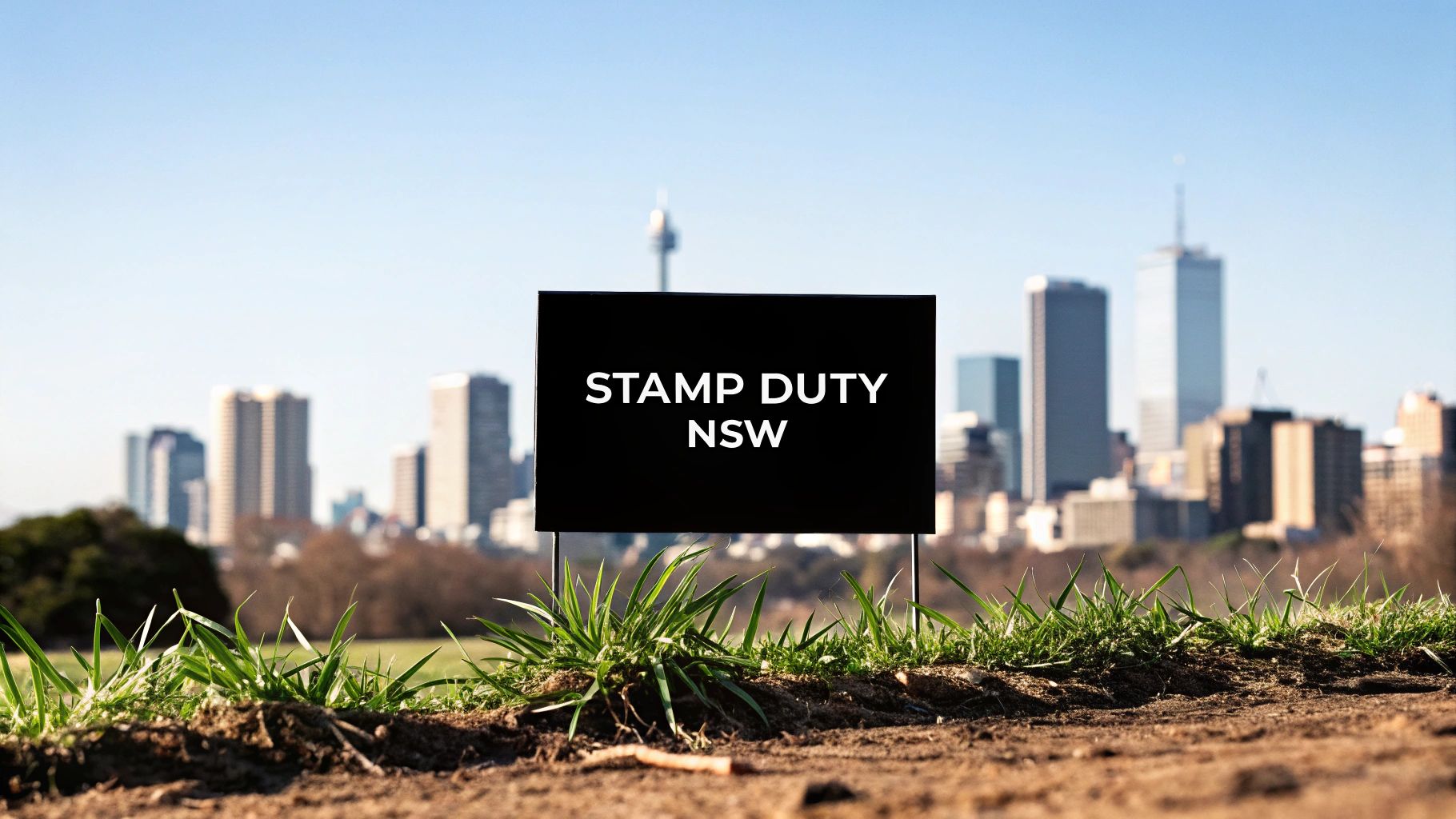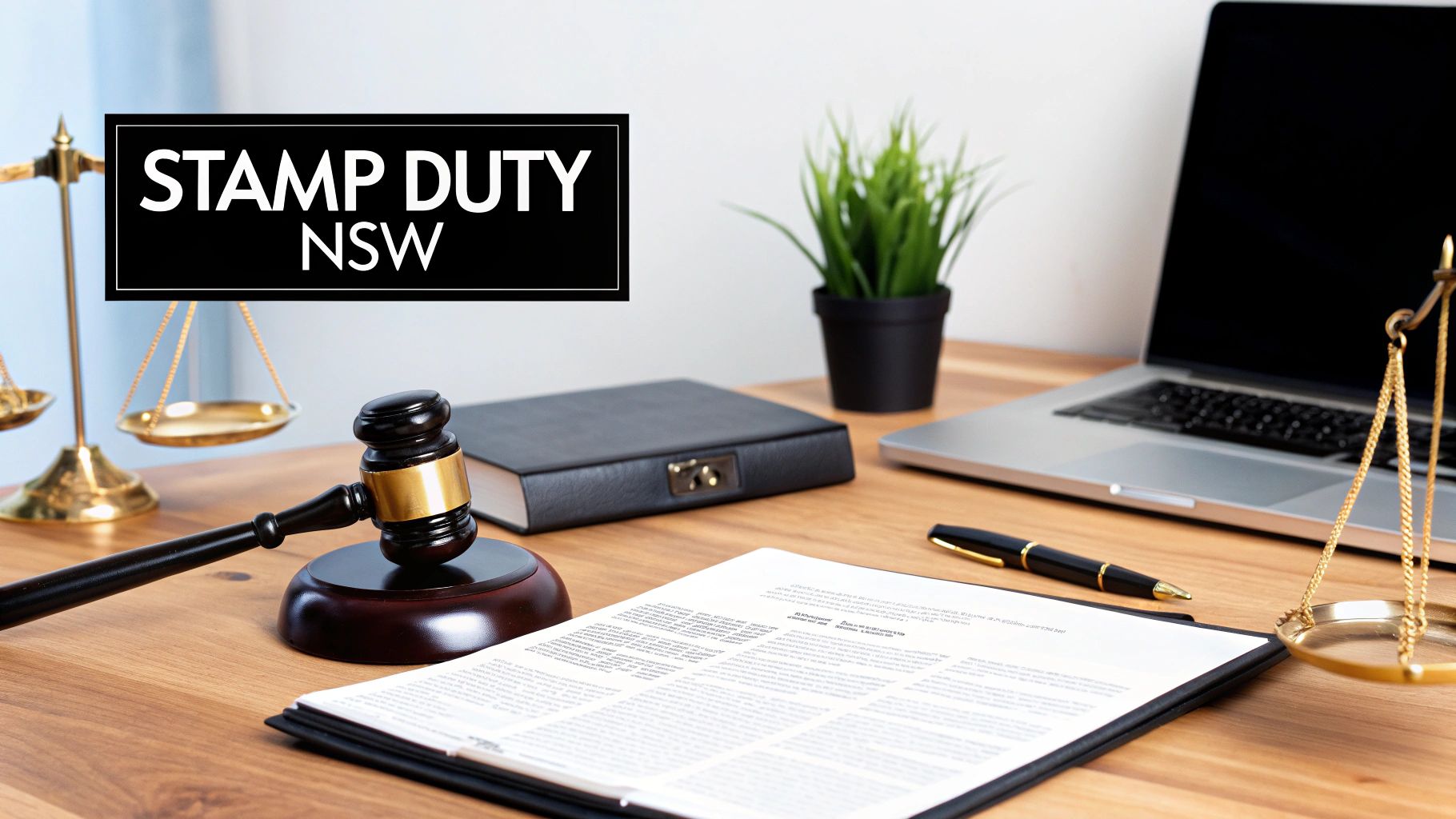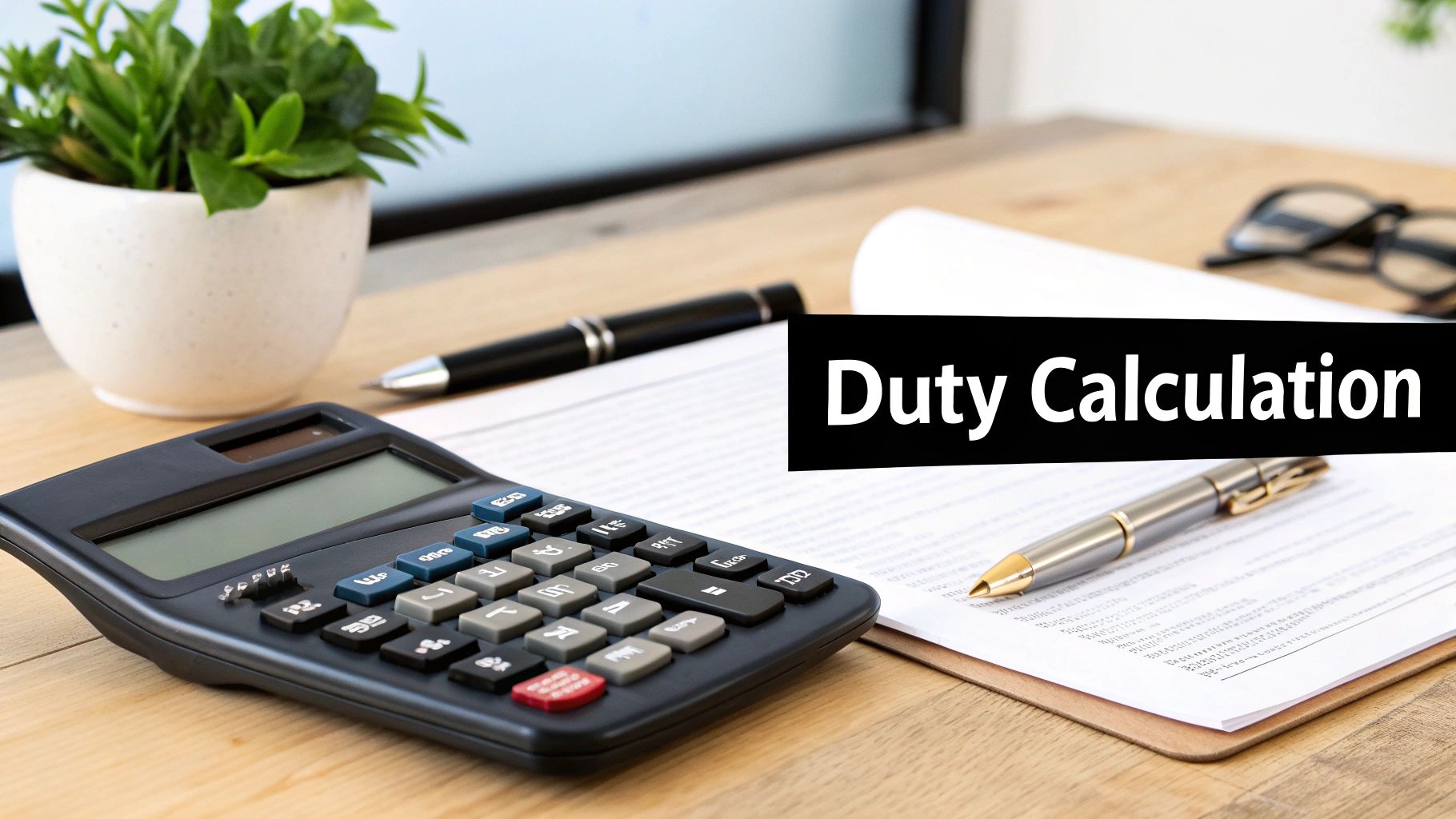
what is stamp duty nsw: Your Quick Guide
Learn what is stamp duty nsw with expert cost tips, exemptions, and planning advice for buying property.


Learn what is stamp duty nsw with expert cost tips, exemptions, and planning advice for buying property.


Buying property in New South Wales (NSW) comes with significant costs beyond the property's price. A major expense is stamp duty, a state government tax on property purchases. Understanding this tax is crucial for a smooth buying process in NSW. It's a key factor influencing property decisions.
The purchaser is responsible for paying stamp duty in NSW. This substantial payment is due during the settlement process, the final stage of the transaction. You need these funds available to officially own the property. Factoring stamp duty into your budget from the start is essential.
Stamp duty is vital for funding essential public services in NSW, including infrastructure and healthcare. It's a cornerstone of the state's budget. However, this reliance creates a complex link between government finances and the property market.
Stamp duty has been a significant revenue source for the NSW government. Historically, stamp duty revenue has seen substantial growth. Between 2016 and 2020, stamp duties decreased from 31% to 22% of NSW state tax revenues. This shift reflects changes in the property market and the government's use of other revenue streams. The Grattan Institute has suggested replacing stamp duty with a broad-based property tax to address economic inefficiencies. Explore this further here. This reliance makes the government's budget sensitive to property market fluctuations. When the market slows, stamp duty revenue declines, impacting public spending.
The size of stamp duty payments significantly impacts the NSW property landscape. It can make moving or upgrading a property more difficult, especially for first-time buyers. Understanding stamp duty isn't just about the definition; it's about grasping its real-world effects.
This cost can create a “lock-in” effect, discouraging homeowners from selling due to the high cost of buying again. This, in turn, hinders market fluidity. A firm understanding of stamp duty allows you to navigate the NSW property market confidently and make informed financial decisions.

So, we know what stamp duty is and why it's important. But how exactly is it calculated in NSW? This is where understanding the progressive rate structure comes into play. Whether you're buying a small apartment or a sprawling estate, this structure determines the stamp duty you'll pay. Understanding this system is crucial for accurate budgeting.
NSW stamp duty isn't a flat fee. It's calculated on a sliding scale, increasing with the property’s value. It's a bit like climbing stairs; each step up in value takes you to a higher stamp duty rate. This means a significant increase in cost as property values rise.
Stamp duty in NSW is calculated based on property value. For properties valued between $0 and $16,000, the duty is $1.25 for every $100, with a minimum duty of $10. The stamp duty rate increases as the property value climbs, reaching a standard rate peak of $47,295 plus $5.50 for every $100 over $1,168,000. Properties valued over $3 million attract a premium rate, with a maximum duty of $175,830 plus $7.00 for every $100 over $3,505,000. This tiered system reflects how the government levies taxes based on property values. You can find detailed statistics on the Money.com.au stamp duty calculator. This structure can create substantial differences in stamp duty amounts, even for properties with similar market values.
To make this clearer, let’s explore a simplified breakdown of the NSW Stamp Duty Rate Structure. The following table provides examples across various property values:
NSW Stamp Duty Rate StructureA comprehensive breakdown of NSW stamp duty rates across different property value thresholds
This table illustrates the tiered structure of stamp duty and how costs can significantly increase with higher property values. It’s essential to consult the provided link for exact calculations, especially for properties falling within the lower value ranges.
Consider a first-home buyer purchasing a property for $800,000. Their stamp duty will be considerably less than someone purchasing a premium property for $2 million. The difference isn’t solely due to the property price; the escalating rate structure magnifies the cost difference. This emphasizes the importance of accurate stamp duty calculations early in the buying process.
Accurately estimating your stamp duty liability is vital for budgeting. Knowing the precise amount allows for proper financial planning, preventing unforeseen costs during the purchase. This proactive approach can minimize stress and enable you to navigate your property purchase confidently. Consulting a financial advisor or using a stamp duty calculator can offer personalized estimations based on your individual circumstances within the NSW property market. This ensures a smoother and more financially secure property purchase.

Stamp duty in NSW isn't simply a line item on a closing statement; it's a force that significantly shapes the entire property market. This tax has a ripple effect, influencing individual buyer decisions and impacting broader market trends. Through conversations with economists, real estate professionals, and recent homebuyers, we’ll delve into how stamp duty molds the NSW property landscape.
Stamp duty creates a lock-in effect, making homeowners hesitant to sell. Selling a property triggers another round of stamp duty on their next purchase, a cost many are keen to avoid. This reluctance to sell reduces the number of properties on the market, impacting market liquidity.
Fewer transactions can lead to slower price growth and reduced market activity. For example, families may choose to remain in smaller homes even when their needs change, simply because moving is financially prohibitive due to the added burden of stamp duty in NSW.
Stamp duty doesn't impact all buyers equally. First-time buyers, often grappling with limited savings, find this tax a substantial obstacle to homeownership. Similarly, existing homeowners looking to upgrade face considerable costs, hindering their ability to climb the property ladder.
This can create stagnation in specific market segments, preventing the natural progression of buyers and sellers. The added financial strain further complicates an already complex process.
The impact of stamp duty is particularly pronounced in Sydney's premium property market. The higher the property value, the greater the stamp duty levied. This adds another layer of complexity to Sydney’s competitive market, especially for those seeking high-end properties.
The economic burden is considerable, impacting housing affordability and market turnover. In Sydney, stamp duty as a percentage of median house prices has climbed from 1.7% to 3.8% over the past seventeen years. This increase creates significant barriers for those looking to enter or move within the market. For example, the stamp duty on a $4.5 million home in NSW is approximately $232,990, escalating to $1,552,990 for a $28.5 million home. These figures highlight the substantial financial hurdles stamp duty presents. Discover further insights here.
Many experts consider stamp duty an inefficient tax. It discourages property transactions, hinders market fluidity, and ultimately impacts long-term state revenue. This has led to ongoing discussions surrounding potential alternatives, such as a broad-based land tax, which could provide a more stable and less volatile revenue stream. However, implementing such changes often faces political and logistical challenges.
The consequences of stamp duty extend beyond individual transactions. It affects overall housing affordability, market activity, and ultimately, the broader NSW economy. Addressing the challenges posed by stamp duty is crucial for cultivating a healthy and accessible property market. It’s a complex issue demanding careful consideration of both individual circumstances and the overarching economic landscape.

This article delves into the significant role of stamp duty in funding NSW's essential services. Property taxes form a cornerstone of the state's financial foundation. We'll explore how stamp duty collection has evolved and why the government has become increasingly reliant on this revenue stream by analyzing treasury reports and economic data.
Stamp duty revenue has a tangible impact on NSW residents. It directly funds crucial public services, including infrastructure development, education, and healthcare. Understanding how this revenue is utilized is vital for grasping the overall well-being of the state.
For example, a portion of stamp duty payments might go towards constructing new schools or modernizing hospitals. This direct link between the tax and tangible improvements emphasizes the importance of knowing where your money goes.
The reliance on stamp duty, however, presents a significant challenge: volatility. The property market’s inherent fluctuations lead to a boom-and-bust cycle in state finances. When the market is strong, revenue soars. But during market downturns, revenue can plummet, creating budgetary constraints.
This unpredictability complicates long-term financial planning for the state.
This dependence on stamp duty has sparked criticism and calls for reform. NSW has seen stamp duty revenues more than double in recent years, increasing from roughly $4 billion to over $8 billion in just four years. This dramatic rise underscores the state’s dependence on this tax.
The Property Council has criticized stamp duty as the most detrimental tax in NSW, citing its negative impact on the economy and homebuyers. The average homebuyer in Sydney pays approximately $35,000 in stamp duty, adding to the existing housing affordability crisis. More detailed statistics can be found here.
The table below illustrates the revenue trends and their proportion of state tax revenue over time, giving further context to the discussion around stamp duty in NSW.
NSW Stamp Duty Revenue TrendsAnalysis of stamp duty revenue patterns and their proportion of state finances over time
As the table clearly shows, stamp duty revenue has become an increasingly larger portion of state tax revenue over the past five years, correlating strongly with property market conditions. This highlights both the potential and the risk associated with relying so heavily on this single revenue source.
Despite expert recommendations for a more sustainable model, political leaders often hesitate to embrace comprehensive reform. Overhauling the system involves complex political and economic factors. This reluctance is primarily due to the significant revenue stamp duty generates, which is challenging to replace without impacting the state budget.
Furthermore, significant changes to property taxation can create unforeseen consequences for the housing market. This hesitation presents a difficult situation for both the government and homebuyers in NSW. This complex interplay highlights the intertwined relationship between taxation, the property market, and political considerations.
This situation emphasizes the need for continued dialogue and informed discussions regarding the future of property taxation in NSW. Developing a more stable and equitable system is a complex undertaking that necessitates careful analysis and cooperation between policymakers, industry experts, and the public.
Navigating the complexities of stamp duty in NSW can be a daunting task. Many homebuyers are unaware of the potential savings available through various exemptions and concessions. These breaks can significantly reduce, or even eliminate, your stamp duty burden. This section explores these valuable opportunities.
The First Home Buyer Assistance Scheme (FHBAS) offers substantial benefits for first-time homebuyers in NSW. This scheme provides full or partial exemptions from stamp duty, making homeownership more attainable.
Beyond the FHBAS, several other programs and concessions can provide relief. These programs apply to various circumstances, from pensioners and family transfers to relationship breakdowns.
Seeing how these exemptions work in real-life scenarios can be highly instructive. Here are some examples:
Successfully claiming stamp duty benefits requires a clear understanding of the process:
By understanding the available stamp duty breaks and navigating the application process strategically, you can significantly reduce your property purchase costs. Consulting with a financial advisor or conveyancer can help you personalize these strategies and maximize your potential savings in the NSW property market.
After exploring the complexities of stamp duty in NSW, it's time to discuss practical strategies to manage this substantial cost. This section offers a clear plan to integrate stamp duty into your purchase strategy, from initial budgeting to final settlement.
Stamp duty should be a core component of your property budget. Treat it as a separate savings goal alongside your deposit. This approach helps you visualize the total funds required and track your progress.
Saving diligently for stamp duty alongside your deposit helps avoid last-minute financing scrambles. It's all about having a clear financial picture from the outset.
When applying for a loan, clearly communicate your stamp duty obligations to your lender. Transparency with your lender about stamp duty helps them understand your financial position and realistically assess your borrowing capacity. This open communication can streamline the loan approval process.
Understanding when you need to pay stamp duty is critical. Missing the deadline can incur penalties, jeopardizing your purchase.
Stamp duty is typically due at settlement, the final stage of the property transaction. Having the funds readily available is essential. Familiarize yourself with the accepted payment methods, usually via bank transfer, to ensure a smooth and efficient closing.
Your conveyancer plays a vital role in managing the stamp duty process, ensuring all paperwork is correctly completed and submitted on time. Effective communication with your conveyancer is key to minimizing the risk of errors or penalties.
Certain errors can significantly inflate your stamp duty costs. Being aware of these pitfalls can save you thousands of dollars.
Accurate calculation of stamp duty is essential. Use official calculators and consult with professionals. While estimates are helpful for initial planning, final figures should be confirmed. Various stamp duty concessions have strict deadlines; missing these can negate your eligibility. Meticulous tracking and timely applications are vital.
Stamp duty thresholds can be used as leverage during price negotiations. Discuss this with your buyer's agent to explore potential savings. A savvy negotiator can often use these thresholds to your advantage.
The following resources can assist in your planning:
Managing stamp duty strategically is crucial for a successful property purchase in NSW. Planning, attention to detail, and professional guidance can help you navigate this complex process efficiently and minimize costs.
Are you ready to make your property dreams a reality without the stress of navigating the complexities of stamp duty in NSW? Shayne Mele Buyers Agent specializes in securing ideal properties in Australia's competitive markets. We offer expert guidance and data-driven insights. Contact us today to learn how we can assist you in navigating the NSW property market and achieving your real estate goals.